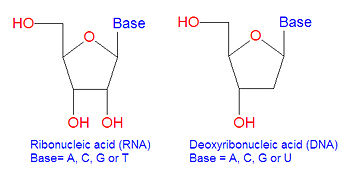RNA: Difference between revisions
imported>David E. Volk (Ribose ring difference RNA and DNA image) |
imported>David E. Volk m (Image size) |
||
| Line 1: | Line 1: | ||
{{subpages}} | {{subpages}} | ||
[[Image:RNA base vs DNA base.jpg|right|thumb| | [[Image:RNA base vs DNA base.jpg|right|thumb|350px|{{#ifexist:Template:RNA base vs DNA base.jpg/credit|{{RNA base vs DNA base.jpg/credit}}<br/>|}}Ribose ring difference between RNA and DNA.]] | ||
'''Ribonucleic Acid''', or '''RNA''' is a [[polymer]] made of only the [[nucleotides]] [[adenine]], [[cytosine]], [[guanonsine]] and [[uracil]], that is used for a variety of biological functions in living systems. In [[cell (biology)|cells]], it is primarily involved the creation of [[protein|proteins]] based the [[genetic code]] stored in [[DNA]]. The primary difference between RNA and DNA is the 2-doubleprime-substituent of the ribose sugar unit. In RNA it is a hydroxyl group (OH), and in DNA it is a proton (thus the deoxy- naming of DNA). The other difference is that uracil is used in place of thymine that is used in DNA. | '''Ribonucleic Acid''', or '''RNA''' is a [[polymer]] made of only the [[nucleotides]] [[adenine]], [[cytosine]], [[guanonsine]] and [[uracil]], that is used for a variety of biological functions in living systems. In [[cell (biology)|cells]], it is primarily involved the creation of [[protein|proteins]] based the [[genetic code]] stored in [[DNA]]. The primary difference between RNA and DNA is the 2-doubleprime-substituent of the ribose sugar unit. In RNA it is a hydroxyl group (OH), and in DNA it is a proton (thus the deoxy- naming of DNA). The other difference is that uracil is used in place of thymine that is used in DNA. | ||
Revision as of 16:50, 10 March 2008
Ribonucleic Acid, or RNA is a polymer made of only the nucleotides adenine, cytosine, guanonsine and uracil, that is used for a variety of biological functions in living systems. In cells, it is primarily involved the creation of proteins based the genetic code stored in DNA. The primary difference between RNA and DNA is the 2-doubleprime-substituent of the ribose sugar unit. In RNA it is a hydroxyl group (OH), and in DNA it is a proton (thus the deoxy- naming of DNA). The other difference is that uracil is used in place of thymine that is used in DNA.
Types of RNA
Messenger RNA
In cells, messenger RNA (or mRNA) is transcribed from a DNA template in the cell nucleus. Unnecessary pieces of the strand, called introns, are spliced out before the mRNA goes to the ribosome, where its sequence is read to create a protein.
Ribosomal RNA
Ribosomal RNA (or rRNA) is synthesized in the nucleolus, a small organelle within the nucleus, where it is formed into the main subunits of the ribosome.
Transfer RNA
Amino acids are brought to the ribosome by small, specially-folded strands of RNA, called transfer RNA (or tRNA). A specific amino-acid-carrying tRNA molecule "reads" the code on the mRNA, bringing in the appropriate amino acid.
